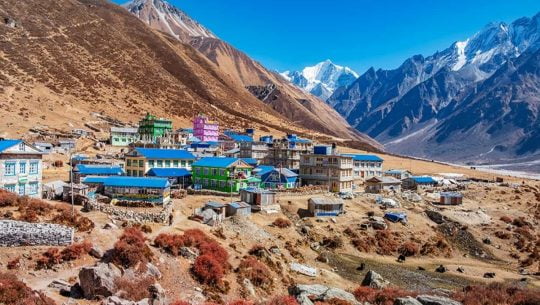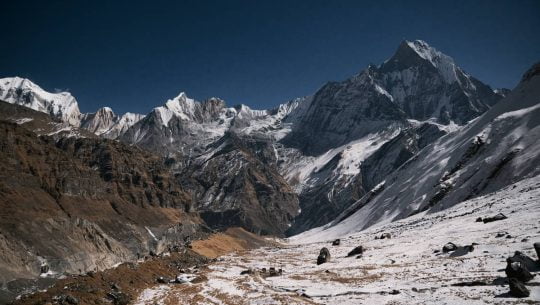+977-9823701757
Mardi Himal Trek
11 Days
Moderate
Mardi Himal Base Camp (4,500 m)
Hotel/Teahouse
Bus/Car/Flight
2-20
Autumn & Spring
Trip Highlights
- Drive through the banks of the Trisuli River.
- A short outing in the beautiful city of Pokhara.
- The astounding views of the Himalayas range of Dhaulagiri and Annapurna.
- Encounter the warm welcome and hospitality of traditional villages.
- Witness flora and fauna in the wilderness during the trek.
- Captivating sunrise view of mighty mountain ranges.
Overview
Mardi Himal Base Camp trek is one of the best trekking destinations in Nepal. It is short and
a little bit challenging but exhilarating at the same time. At the beginning of the trek, there were fewer teahouses on the route to the base camp. In 2012, Nepal Government declared the initiation of trekking in the lap of Mardi Himal. Thereafter, more teahouses are available at the trekking stop points.
The Mardi Himal Base Camp trek is also an alternative to the Annapurna Base Camp trek. It offers a dazzling view of Annapurna ranges; Annapurna I, Annapurna South, Machhapuchhre, Hiuchuli, Gangapurna, Tare Kang, Khangsar, and many more. Not only that, the panoramic view of Mardi Himal itself is breathtaking. The trail follows the route through rhododendron, oak, and maple forests. Several species of birds and animals are the inhabitants of the jungle.
The base camp lies at an elevation of 4,500 m, presenting a dramatic view of mountain ranges. The feeling of standing in the lap of Mardi Himal is overwhelming.
Mardi Himal stands at an altitude of 5,587 m from sea level just underneath the prestigious Mt. Machhapuchhre. Basil Goodfellow was the first to the summit in 1961. Mardi Himal is claimed to be one of the trekking peaks by the Nepal Government.
Pokhara is the initial and end point for the trek. The journey begins from Kathmandu to Pokhara via bus or flight. After that, a drive follows a route to Kande from where the actual trek starts off. The trail is an uphill climb guiding to Pothana and Deurali soon after. With stunning views of Annapurna and Dhaulagiri ranges along with the wilderness, the route comes to Low Camp.
Here onwards, the trail passes through the forests of rhododendron, leading to High camp. Now, the trekking journey is close to the destination. After reaching High camp, the base camp at an altitude of 4,500 m awaits ahead. The mesmerizing view from the base camp is worthwhile and rewarding. The time spent here is truly exceptional. Soon enough, the route leads back to the start point via different pathways, this time through Siding village. The trekking ends in Pokhara.
The trek is not strenuous but somehow a bit rough. So, an individual’s physical fitness determines the trek’s success. The trail to the base camp follows through rocky sections at a high altitude from sea level. Therefore, an average level of fitness is required.
Outline Itinerary
- Day 01: Kathmandu Arrival
- Day 02: Sightseeing in Kathmandu (or Spare Day)
- Day 03: Drive from Kathmandu to Pokhara
- Day 04: Drive from Pokhara to Kande and trek to Deurali
- Day 05: Trek from Deurali to Low Camp
- Day 06: Trek from Low Camp to High Camp
- Day 07: Trek to Mardi Himal Base Camp and back to High Camp
- Day 08: Trek from High Camp to Siding Village
- Day 09: Trek from Siding Village to Lumre and drive back to Pokhara
- Day 11: Final Departure
Detailed Itinerary
Day 01: Kathmandu Arrival
We’re so excited to welcome you to Kathmandu!
We know you’ve got a lot on your mind, and we want to make sure you’re taken care of during your stay. Our airport representative will meet you at the airport and take you to one of our pre-booked hotels, where your room will be waiting for you.
After freshening up and checking in, wander around Thamel in the evening. There are lots of food options there!
Overnight in Kathmandu.
Day 02: Sightseeing in Kathmandu (or Spare Day)
After breakfast, our guide will meet you at the hotel lobby to take you to the Pashupatinath temple. This is a must-see site, with its towering golden spire and ancient stone carvings. You’ll also stop at Swayambhunath, another architectural marvel that is considered one of the most sacred sites in Nepal.
Next, we’ll head over to Patan Durbar Square for an evening tour. This historic site is home to many important buildings and sculptures, including old palaces and temples from different eras in Nepal’s history.
Finally, we’ll escort you back to your hotel so you can rest up for tomorrow’s trip!
Overnight in Kathmandu.
Day 03: Drive from Kathmandu to Pokhara
Pokhara is the gateway to trekkings in the Annapurna Circuit. So, you leave Kathmandu by bus. The drive follows through the banks of the Trisuli river with a view of hills, villages, and terrace farming. On getting closer to the destination, a splendid view of mountain ranges comes into view if the weather is clear. After a long drive, you arrive at Pokhara. You can register into the hotel, rest for a bit, and head out for a short trip to the city.
Pokhara is a beautiful city with a flourishing tourism industry. Lakes, World Peace Pagoda, cave, Seti river, Sarankot, and many more are the main attractions. You can enjoy your time in the periphery of Fewa lake and adore its beauty. As the day ends, you can prepare for trekking and get a good amount of sleep for tomorrow’s trek.
Overnight in Pokhara
Day 04: Drive from Pokhara to Kande and trek to Deurali
We start our journey to Mardi Base Camp early in the morning. Our officials will pick you up from the hotel, and we will drive towards Kande, leaving Pokhara. The scenery view of verdant hills, subtropical forest, terrace fields, and mountain ranges distant away during the drive is incredible.
Kande is the initial of the trek. The trail is a straightforward uphill hike. After an hour of drive to Kande, we ascend through the wilderness and local villages to reach Australian Camp.
After that, we continue our hike to Pothana. It is the checkpoint for entry permits for TIMS (Trekkers’ Information Management System) and ACAP (Annapurna Conservation Area Project). Soon enough, the route leads us to Deurali. The glance of the Annapurna mountain ranges is overwhelming during the trek.
Overnight in teahouse lodge at Deurali.
Day 05: Trek from Deurali to Low Camp
After having a hearty breakfast, we head out of Deurali. The trail is an ascending climb through a steep climb. The majestic views of the Annapurna and Dhaulagiri ranges are mesmerizing during the trek.
With the continuous hike, we walk past the beautiful forests of rhododendron, oak, and maple. Along the way, different species of birds, animals, and plants can be seen. Soon after, we reach Forest camp. Locally, the Forest camp is known as Kokar. Moving further ahead, we climb up through forest mainly of rhododendron to a greater extent. You can see moss and ferns growing in trees in this region. And thus, we arrive at Low Camp.
Overnight in a lodge at Low Camp.
Day 06: Trek from Low Camp to High Camp
The trek to High Camp is an uphill climb. We leave Low Camp after having breakfast. The route guides to the middle camp, walking past a rhododendron forest. Afterwards, we reach Badal Danda. The awe-inspiring view of Mardi Himal itself is eye-catching from here.
Other mountain ranges; Mt. Annapurna, Machhapuchhre, Hiuchuli and Gangapurna can also be seen. We arrive at High Camp by moving further and following the route through a grassy ridge.
Overnight in a lodge at High Camp.
Day 07: Trek to Mardi Himal Base Camp and back to High Camp
The trek to the main destination will be accomplished today. The trek begins with an early morning hike for the sunrise scenery of the mountain ranges.
We head out of the High camp through a rocky trail. Along the way, we walk through pasture lands with scenic beauty and a couple of steep pathways. Then we set foot on Mardi Base Camp. However, we can hike up to the viewpoint halfway back instead of getting to the base camp.
Reaching the base camp is heartwarming and rewarding by the panoramic views of the Himalayas. The spectacular view of Annapurna I, Annapurna South, Machhapuchhre, Hiuchuli, Tare Kang, and Khangsar is mind-blowing. After spending a glorious moment, we follow the route back to the High Camp.
Overnight in a lodge at High Camp.
Day 08: Trek from High Camp to Siding Village
After accomplishing the trek to the base camp, the journey is coming closer to its end. We retrace via different routes.
We make our way down to Siding village instead of returning to Forest camp. We walk through the forest leading to Mardi Khola and reach the Siding village. The warm welcome and friendly hospitality are excellent. There are mainly homestays in the village.
Overnight at Siding village.
Day 09: Trek from Siding Village to Lumre and drive back to Pokhara
Today we will be heading back to Pokhara to conclude the trek. After having a hearty breakfast, we make our way down to Lumre. The trail follows through the edges of the Mardi river valley. We walk past Tamang and Gurung settlements and reach Lumre. Here onwards, we drive back to Pokhara with amazing wilderness views.
Day 11: Final Departure
We’ll be driving you back to your airport after breakfast, which means you’ll have to fight back from the Kathmandu airport and then get yourself home. We hope you enjoyed your time in Nepal and will be back soon!
(Note: The trek to Mardi Himal Base Camp takes 6 days if the starting and end point is Pokhara.)
What is included in Mardi Himal Trek
- Meals
- Accommodation
- Drive fare as per itinerary
- Flight fare, if necessary
- An experienced and English-speaking guide
- Porters
- Government taxes
- TIMS and ACAP permits
What is Excluded
- Personal Expense
- Trekking Gear
- Sightseeing
- Any kinds of beverages
- Tips to guide and porter
- Travel Insurance
- Emergency Rescue
- Nepal Entry Visa Fee
- International Flight
Best Time
The most promising time to trek the Mardi Base Camp is during autumn and spring. The weather during autumn is stable with appropriate temperatures. The clear sight of spectacular mountain ranges can be seen through clear skies. Due to this, autumn is considered to be the most preferred season for tours and trekking.
Likewise, the temperature is moderate with fair weather during spring. Rhododendron blooms in the forests at this time which adds beauty to nature. Trekking can be enjoyed to its fullest.
Despite this, the trek is possible in other seasons as well. However, the trek can be harsh during the monsoon season due to heavy rainfall leading to floods and landslides.
Gear and Equipment
Clothes:
- Down Jacket
- Windcheater
- Cap
- Gloves
- Warn woolen socks
- Quality trekking boots with gripping sole
- Muffler/ scarf
- Warm trouser
Equipment:
- Trekking poles
- Headlights
- Sleeping bag
- U-lock
- Oxygen
- Survival blankets
- Insect repellent, etc.
Electronics:
- Phone charger
- Power bank
- Torch
- Headlight
- Headphone/ earphone, etc.
Others:
- Dry foods
- Trekking map
- Snacks
- Mineral water
- Prescribed medicines
- Water bottle, etc.


